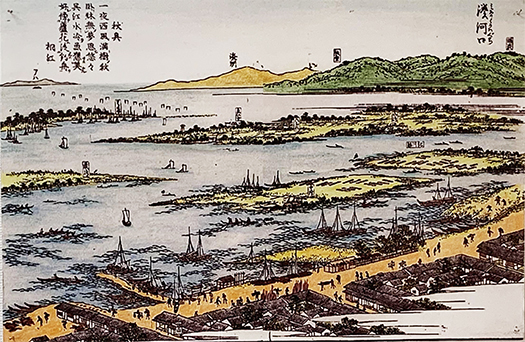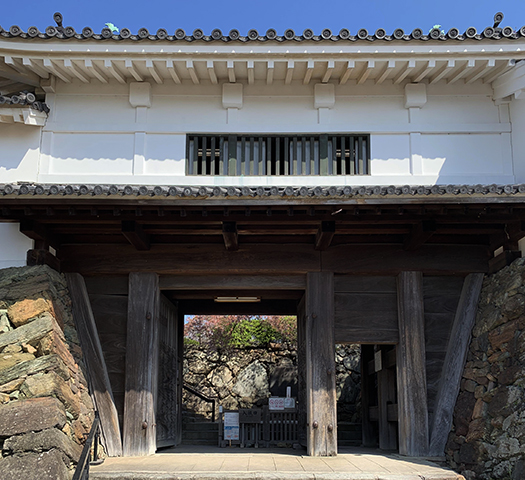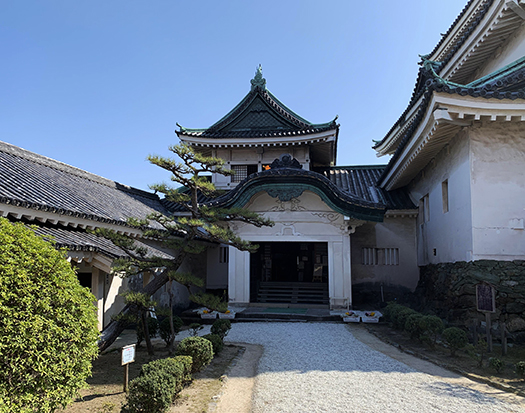


和歌山城は1619年に御三家として徳川家がこの地に入府する。
全国支配構造のなかでこの地がいかに枢要であったかを示している。
和歌山県には宗教聖域として高野山があり、そこから分派して
全国有数の「鉄砲軍団」として根来寺を中心とした勢力もあった。
そして雑賀衆という、これも鉄砲軍団として全国に傭兵として
活躍した独立不羈の勢力がある、戦国武将としてはきわめて統治しにくい地域。
秀吉の全国統一政権成立の過程では「雑賀攻め」が重要なメルクマール。
いわば自由の中世を謳歌した武装勢力を秀吉が鎮圧したもの。
そしてその血生臭い戦乱のあと、豊臣政権として弟・秀長が統治を任され
ほぼ直轄のカタチで地域運営されていった。
現代のロシアによるウクライナ侵略とも類推されるけれど、
支配者の秀長はプーチンよりもはるかに賢明だったと思える。
平定後、1586年から和歌山築城が秀吉の命で藤堂高虎によって進められた。
後に「城造りの名人」とされたかれの最初期造営とされる。
地政学的な巨視把握と地形観望については秀吉の直感が大きかったと言われる。
巨視的戦略眼でこの地を地域支配の拠点に定めたのでしょう。
秀吉政権の性格から言っても商業重視であることは間違いなく、
大きくは紀ノ川の水運と瀬戸内海海運と太平洋側海運の重要な結節点にあり
西国支配のために大阪を支える要衝地という判断だったのでしょう。
このような地域の把握はそれまでの雑賀衆の繁栄ぶりをみれば自明ではある。
当然ながら秀吉の戦略眼は確かで、後の御三家配置も納得できる。
で、わが家系とのからみですが、
1586年ころからの豊臣秀長支配とその「代官」桑山氏への「仕官」が
どうやらその後の推移を見ると自然な流れだと思える。
で、きのう見た「三木町」も立地として商業者の根拠地町であり、
推測では旧来の雑賀衆時代から形成されていたのではないかと。
写真の「岡山口」という和歌山城の重要入口は地理で言えば
旧勢力の雑賀衆根拠地であった「岡」にも近接している。
城としての玄関口をすでに形成されていた往来中枢地域へ立地させている。
三木という名は瀬戸内海海運の重要港湾であった播州「英賀」に
城郭を持っていた三木氏に関係すると推測できます。
こうした中世商業者ネットワークというのは宗教勢力との結びつきが強い。
商業というのは活発に地域間を往来するけれどその「通行手形」として
宗教というのはもっとも信用力を持っていた。
そこで本願寺勢力と雑賀衆との連携もそういう商業ネットワークとして自然。
英賀三木氏は本願寺の根拠寺院・英賀御堂を招致するほど昵懇だった。
旧石山本願寺は大阪城の位置を占めていてその物流について、
瀬戸内海播州の英賀港とこの紀州和歌山は連携していたと考えられる。
英賀と和歌山の直接の交易関係もあって当然だろうとの推測。
さてこのコンパス軸、これからいろいろに実証を重ねていきたい。
いくつかの手掛かりを、わかやま城歴史館の学芸員さんから得られたので、
情報確度を高めていきたいと考えています。
English version⬇
Geopolitics and Economy of Wakayama Castle Nara and Wakayama Exploration-24
Speculation on the interaction between the Zoka Shu and the Seto Inland Sea water transportation. Banshu Eiga Miki clan and “Miki Town” in Wakayama. Searching for the missing link in history. …
Wakayama Castle was built in 1619, when the Tokugawa family entered the area as one of the three Imperial families.
This shows how important this area was in the national ruling structure.
In Wakayama Prefecture, there is Koyasan as a religious sanctuary, from which the Koyasan sect diverged.
Koyasan as a religious sanctuary, and from there, there was the Negoroji Temple as one of the leading “gun corps” in the country.
The Zoga-shu, another artillery corps, were independent and unrestrained forces that were active as mercenaries throughout the country.
It was an extremely difficult region to govern for a warlord.
In the process of Hideyoshi’s unification of the whole country, the “Zoga attack” was an important merkmal.
It was Hideyoshi’s suppression of the armed forces that enjoyed a free medieval period, so to speak.
After the bloody war, Toyotomi’s younger brother, Hidenaga, was appointed to rule the region.
The region was administered almost directly by the Toyotomi government.
This is analogous to the modern Russian invasion of Ukraine.
Hidenaga was much wiser than Putin.
After the conquest of Wakayama, Hideyoshi ordered Takatora Todo to build a castle in Wakayama from 1586.
It is said to be the first castle built by Takatora Todo, who was later regarded as a “master castle builder.
It is said that Hideyoshi’s intuition was significant in his macroscopic understanding of geopolitics and topography.
It is likely that his macroscopic strategic vision led him to establish this site as a base for regional control.
The character of Hideyoshi’s administration was definitely focused on commerce.
The area was located at an important node for water transportation along the Kino River, the Seto Inland Sea, and the Pacific Ocean side.
It is likely that Hideyoshi’s administration considered the area to be a strategic point that would support Osaka in its domination of the western part of the country.
Such an understanding of the region is self-evident from the prosperity of the Zoka Shu up to that time.
Naturally, Hideyoshi’s strategic eye was solid, and his later placement of the three families was also understandable.
Now, let me tell you how this relates to my family line.
The rule of Toyotomi Hidenaga from around 1586, and his “official” to the Kuwayama clan, the “deputy” of Toyotomi Hidenaga, are the reasons why the Gozan family was placed under the control of Hideyoshi.
It seems to me that the subsequent transition of the family is a natural flow of the family.
Miki-machi,” which we saw yesterday, is also a town that is a base for merchants.
My guess is that it was formed during the Zoka Shu period.
The important entrance to Wakayama Castle called “Okayamaguchi” in the photo is located in a geographical area.
The entrance to Wakayama Castle, called “Okayama-guchi” in the photo, is located in close proximity to “Oka,” which was a former Zoga-shu stronghold.
The entrance to the castle is located in an area that had already been formed as a traffic hub.
The name “Miki” is related to Miki, who had a castle in Eiga, Banshu, which was an important port for shipping on the Seto Inland Sea.
The name Miki can be assumed to be related to the Miki clan, which had a castle in Eiga, Banshu, an important port for shipping on the Inland Sea.
This network of medieval merchants has strong ties to religious powers.
Commerce was a means of transportation between regions, but religion had the most credibility as a “bill of passage” between regions.
Religion had the most credibility as a “handbill.
Therefore, the collaboration between Honganji forces and the Zoga was a natural part of such a commercial network.
Eiga Miki was such a close friend that he invited Eiga Godo, a temple based on Honganji.
The former Ishiyama Honganji occupied the location of Osaka Castle and its logistics.
It is thought that the port of Eiga in Banshu on the Seto Inland Sea and the port of Wakayama in Kishu were linked.
It is natural to assume that there was a direct trade relationship between Eiga and Wakayama.
Now, I would like to continue to verify this compass axis in various ways.
We have obtained some clues from the curator of Wakayama Castle History Museum.
I would like to improve the accuracy of the information.
Posted on 5月 12th, 2022 by 三木 奎吾
Filed under: 住宅マーケティング, 歴史探訪







コメントを投稿
「※誹謗中傷や、悪意のある書き込み、営利目的などのコメントを防ぐために、投稿された全てのコメントは一時的に保留されますのでご了承ください。」
You must be logged in to post a comment.